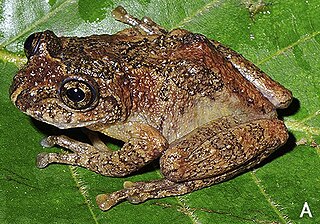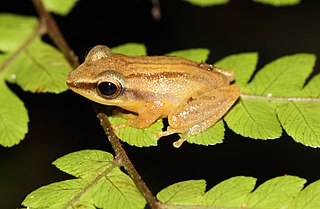The Medog horned toad, or Medog spadefoot toad, is a species of frog in the family Megophryidae. It was described as a subspecies of Omei horned toad based on specimens collected from Mêdog County, Tibet (China); it is still only known from its type locality. It probably has a wider distribution that may reach India. Its natural habitats are subtropical or tropical moist lowland forests, subtropical or tropical moist montane forests, and rivers.
Liurana medogensis, commonly known as Medog papilla-tongued frog or Medog eastern frog, is a species of frog in the family Ceratobatrachidae. It is found in Mêdog County, Tibet (China) and in Arunachal Pradesh, northeastern India. However, the records from India might represent another species, and the IUCN SSC Amphibian Specialist Group (2020) does not include them in the range of this species.
Orixalus ananjevae, the Ananjeva Asian treefrog, is a species of frog in the family Rhacophoridae.
Pseudophilautus dimbullae is an extinct species of frog in the family Rhacophoridae. It was endemic to Sri Lanka. It is only known from the holotype collected in 1933.
Pseudophilautus eximius is an extinct species of frog in the family Rhacophoridae. It was endemic to Sri Lanka. It is only known from the holotype collected in 1933.
Pseudophilautus halyi, known as pattipola shrub frog, is an extinct species of frog in the family Rhacophoridae. It was endemic to Sri Lanka. It is only known from the holotype collected in 1899. The specific name halyi honours Amyrald Haly, the first director of the Ceylon Museum, author of the "Natural History of Ceylon", and the collector of the holotype.

Nasutixalus jerdonii is a species of frog in the family Rhacophoridae. It is found in the northeastern India, in the West Bengal, Nagaland, Manipur, and Meghalaya states. It range might extend into the adjacent Nepal. The specific name jerdonii honours Thomas C. Jerdon, an English herpetologist. Common names Jerdon's bubble-nest frog, Jerdon's tree frog, and Jerdon's bush frog have been coined for this species.

Pseudophilautus variabilis, also known as the variable bush frog or variable bubble-nest frog, is a species of frog in the family Rhacophoridae. This now extinct species was endemic to Sri Lanka. Despite extensive searches in recent times, it is only known from collections prior to 1858. The reasons for its disappearance are unknown but probably involve habitat loss.
Pseudophilautus pardus is an extinct species of Sri Lankan shrub frogs in the family Rhacophoridae. Despite extensive surveys in recent years, the species is known only from a collection made prior to 1858. The reason for its extinction is unknown but probably relates loss of forests.
Theloderma palliatum is a species of frog in the family Rhacophoridae. It is endemic to Vietnam and so far only known from the Bidoup Núi Bà and Chư Yang Sin National Parks. This species, together with Theloderma nebulosum, was first found by Australian and Vietnamese scientists in Tay Nguyen in 2011.

Gracixalus is a genus of shrub frogs from south-eastern Asia.
Gracixalus nonggangensis is a species of shrub frog found in southern Guangxi, China, and Cao Bang Province in northern Vietnam.
Gracixalus quangi is a species of bush frog endemic to Vietnam, Laos, and China, where it has been observed between 550 and 1300 meters above sea level.

Gracixalus lumarius, also known as the thorny tree frog or thorny bushfrog, is a species of rhacophorid frog. It is endemic to Vietnam and first known from Mount Ngoc Linh in Ngoc Linh Nature Reserve, Kon Tum Province. It has been observed between 1700 and 2160 meters above sea level.

Sri Lanka petite shrub frog,, is a species of frogs in the family Rhacophoridae, endemic to southwestern Sri Lanka. This relatively recently described species is only known from two locations in the Galle District, Beraliya and Kanneliya Forest Reserves. The specific name tanu is Sinhalese for "slender" and refers to the habitus of this frog.

Nasutixalus is a genus of frogs in the family Rhacophoridae. The genus is found in northeastern India and adjacent southeastern Tibet as well as western Yunnan (China); the range might extend into the adjacent Nepal and Myanmar. Common name ridged-nose treefrogs has been coined for this genus.
Gracixalus trieng, also known as the Trieng tree frog or Trieng bushfrog, is a species of frog in the family Rhacophoridae. It is endemic to Vietnam and is only known from the area of its type locality, Ngoc Linh Nature Reserve in Đắk Glei District, Kon Tum Province. Mount Ngoc Linh and adjacent peaks form an isolated high-elevation area and the species is unlikely to exist elsewhere.
Gracixalus seesom, also known as the orange bush frog or orange bushfrog, is a species of frog in the family Rhacophoridae. It is endemic to northwestern Thailand and is known from the Kanchanaburi and Chiang Mai Provinces.
Gracixalus jinggangensis, the Jinggang tree frog, is a species of frog in the family Rhacophoridae. It is endemic to China, where it has been observed on Mount Jinggan in Jiangxi Province.
Gracixalus guangdongensis, the Guangdong tree frog, is a species of frog in the family Rhacophoridae. It is endemic to China, where it has been observed in Guangdong Province and Hunan Province.




